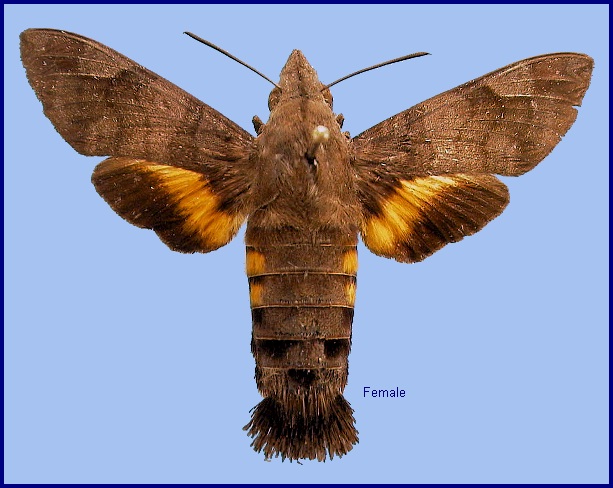
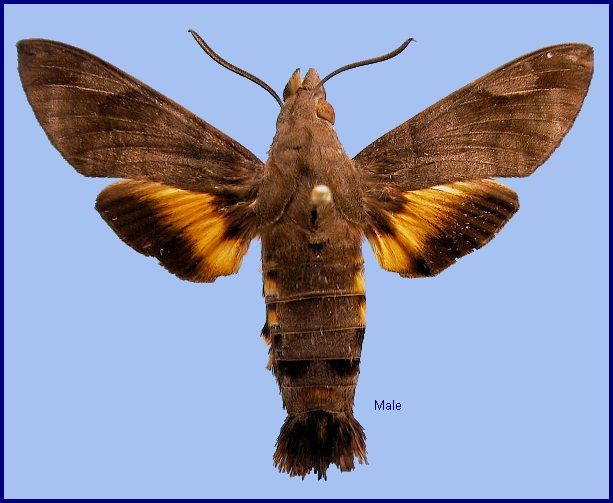
Sphinx belis Linnaeus, 1758, Syst. Nat. (Edn 10) 1: 493. Type locality: "in calidis regionibus".
Synonym. Sphinx belis Linnaeus, 1758.
Synonym. Macroglossa opis Boisduval, 1875.
Synonym. Macroglossa pyrrhula Boisduval, 1875.
Wingspan: 50--60mm. Forewing upperside with two antemedian lines, slightly converging anteriorly, the space between them filled, but the band not prominent; first and second discal lines evenly curved costad anteriorly, the second the heavier, the space between them partly filled with dark scaling, especially anteriorly, the lines straight or slightly incurved posteriorly; dark subapical patches not prominent; grey costal space sharply limited at its proximal side by vein M1. Underside of both wings hazel-chestnut, rather brighter than the abdomen. Hindwing upperside median band cadmium-yellow; base and distal border blackish-brown, the border less deep in colour along the median band. Hindwing underside inner area cadmium-yellow.
Antenna with terminal segment about as long as subterminal 5 together. Abdomen upperside with three separate, cadmium-yellow lateral patches, the first the smallest, transverse; fifth segment with a lateral dark brown or black patch, repeated dorso-laterally on the sixth, and mesially on the seventh; tips of side tufts white. Palpus white with some brown scales. Underside of thorax and legs russet-wood-brown, middle of prosternum more grey. Abdomen underside clayish cinnamon-rufous, the basal sternite and a large indistinct mesial apical patch on second and third segments russet-wood-brown.
Similar to Macroglossum vacillans, but distinguished by the absence of a yellow patch from the fourth abdominal segment, and the much paler yellow band of the hindwing. Male genitalia very similar to those of Macroglossum vacillans, but valve with stridulatory scales.
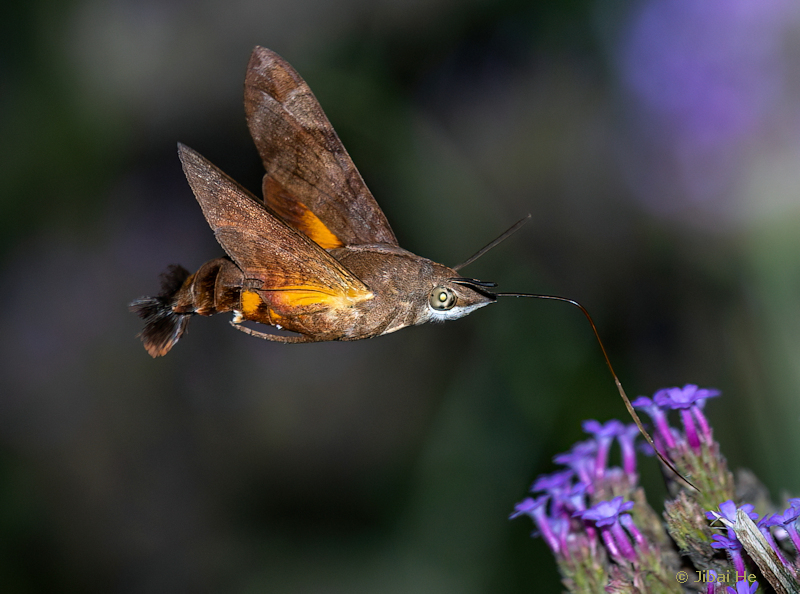
Attracted at dawn and dusk to the flowers of Duranta erecta and Lantana camara. Will occasionally come to light.
China: 27.iv (Jiaozi Xue Shan/Jiaozi Snow Mountain, Yunnan); v (Ailao Shan, Yunnan); 14.v (Hong Kong); v-vii (Hainan); 2.viii (Zhejiang); 29.ix (Hong Kong); 2.xi (Hong Kong).
OVUM: Pale olive-green, slightly oval (0.85 x 1.00mm), shiny and smooth (Bell & Scott, 1937).
LARVA: Full-fed 50mm, width 8mm, horn 7mm. According to Bell & Scott (1937), in the first instar head and anal segments yellow, rest of body bluish-green; horn black, straight, bifid, of medium length. In the second instar, green and dark forms appear. In the green form head and segment 2 pale green, rest of body darker green dotted with white. There is a broad dark green dorsal stripe with a broader pale green stripe on each side of it, and a narrow dark green dorso-lateral stripe. The horn is pink with black tubercles. In the dark-coloured form the head is orange, the body very dark green, almost black, dotted with white.
By the third instar horn long, curved upwards and tuberculate. In the green form head and body green dotted with white, with a broad dark green dorsal stripe. There is also a narrow pale yellow dorso-lateral stripe; horn pale green, tubercles black. In the dark-coloured form, horn, legs, prolegs, anal flap and claspers shiny; head greenish-brown; segment 2 dark brown with a band of degraded pink near front margin. Segments 3 and 4 greenish brown, rest of body pale crimson, dotted with white. There is a greenish-brown dorsal stripe, a narrow white dorso-lateral stripe with a broader stripe of very dark greenish-brown below it, and below this a still broader spiracular stripe of pinkish brown. Spiracles lying on reddish patches; horn black with black tubercles; legs, shanks of prolegs, anal flap and claspers black. The fourth instar is similar for both forms (Bell & Scott, 1937).
In the fifth instar, head square with rounded edges. Clypeus triangular, apex acute, less than one-half length of head. False clypeus with apex a narrow gothic arch reaching to slightly more than one-half length of head. Labrum less than one-half length of clypeus and not quite so broad as clypeus; ligula kidney-shaped, as long as labrum and two-thirds as broad; cutting edge of mandible shallowly, coarsely toothed. Surface of head dull, covered with minute, conical, glassy tubercles. Body with dull surface; horn straight, of medium length.
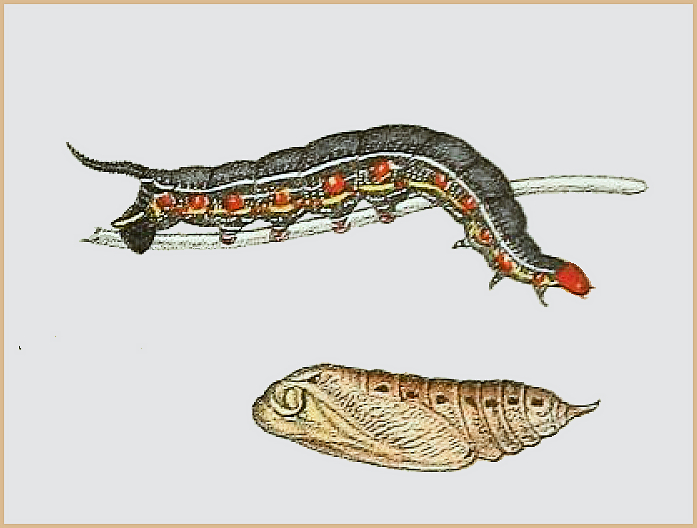
Polychromatic, with green, black and pink forms [A plate from Butler (1876)]. The colouring of the green and dark forms is as described for the third instar. In the pink form, head a degraded rust-colour or greenish-red, with an indistinct yellowish subdorsal stripe and a yellowish stripe separating face from cheek. Labrum, ligula and mandible green, the last with tip black; antenna greenish with a rusty tinge. Body pink above the dorso-lateral stripe, glaucous-green below it, the whole dotted with white. Segment 2, the subspiracular region of 3 and 4 and venter of 5 and 6 suffused with yellowish-brown; other segments slightly suffused with orange in spiracular region. There is a faint, neutral-coloured dorsal stripe, and a white dorso-lateral stripe from 3 to base of horn, which is very broad and well-defined on 12. There is also a yellow, interrupted subspiracular stripe from 5 to tip of anal flap. Horn black, with black tubercles; legs red, with black claws and basal segment (These features distinguish the larva from that of M. affictitia). Prolegs with a black band on front surface near base. Spiracles oval, flush, orange, the surface of the body round them suffused with dull orange (Bell & Scott, 1937).
The larvae closely resemble those of Macroglossum affictitia in appearance and habits; both can be found together on the strychnine tree (Strychnos nux-vomica).
PUPA: 40 mm, width 11 mm. Colour pinkish bone-colour; head, thorax and wing case translucent; tongue-case, legs, antenna and wing-case transversely banded with leaden grey. There is a narrow black dorsal stripe on the head, vertex and thorax. Dorsum of abdomen rusty, sides paler, pits rusty; cremaster reddish-brown. Spiracles black, those on the abdomen lying in quadrate black patches. Tongue-case more prominent than in M. affictitia, semicircular in side-view; tip of tongue spatulate. Antenna equal to fore leg and reaching to about one-third the wing-case, mid-leg about one-half. Surface shiny, head, thorax and wing-case smooth. Abdomen closely pitted; front bevel of segment 9 set with short, irregular ridges covering the whole bevel. Spiracle of 2 a slit curving forwards, the hind margin of 2 and front margin of 3 thickened and curved in conformity with the slit; remaining spiracles broadly oval. Cremaster elongate triangular, tip emarginate-truncate, with a conical setiferous tubercle, directed straight backwards, at each lateral angle of the truncation (Bell & Scott, 1937).
Larval hostplants. Strychnos angustiflora (Loganiaceae) in Hong Kong. On Strychnos nux-vomica, Saprosoma indicum and Spermadictyon suaveolans (Rubiaceae) in India (Bell & Scott, 1937). In Taiwan it has been recorded from Paederia foetida.
China: Zhejiang (Nanji Islands National Nature Reserve, Wenzhou); Chongqing (Fengjie); Yunnan (Ailao Shan; Jiaozi Xue Shan/Jiaozi Snow Mountain, 2900m); Guangdong (Shantou); Macau; Hong Kong (North Point); Hainan (??Secha; Chengmai).
Japan: Ryukyu Archipelago.
From northern Pakistan (Rafi et al., 2014; Humairah Hanif et al., 2016), east and south throughout India (Pathania, Sunita Sharma & Gill, 2014), Sri Lanka, Nepal, Bhutan (Irungbam & Irungbam, 2019), Bangladesh, Myanmar/Burma, Thailand, Laos, Cambodia/Kampuchea, and Vietnam (Le & Vu, 2024), to southeastern China, Taiwan and the Ryukyu Archipelago of Japan.
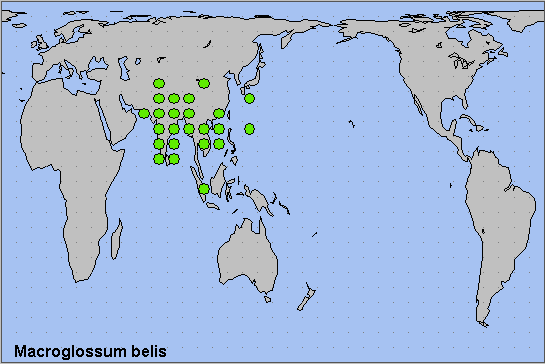
 Return to Sphingidae of the Eastern Palaearctic species list
Return to Sphingidae of the Eastern Palaearctic species list